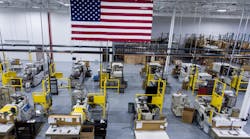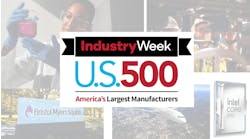Switching from ERP to MES Drives Improvement for Plastics Manufacturer
It’s okay to admit that your enterprise resource planning (ERP) system isn’t up to the task of increasing efficiency, lowering scrap rates, determining ideal cycle times and everything else you get from digitization and data analysis.
Patrick Austin, president at Midwest Precision Molding in Lake Geneva, Wisconsin, has a background in finance, working for manufacturers such as Snap-on Tools and Masterlock. He’s also been responsible for HR and IT departments at other companies. So, when his family purchased plastics manufacturers Plasti-Coil and Tri Tec, he came on board to merge the companies.
At previous positions Austin ran point on manufacturing execution system (MES) implementations and understood their value. He also knew many manufacturers often embrace custom modules or reports for their existing ERP system, an easier route in the short-term. It can also make life very difficult (and expensive) for a manufacturer that wants to keep building on the software.
So, Austin decided to change the company over from an ERP system to MES software. If not for this fortuitous decision, MPM might have failed to handle the COVID-19 epidemic that slammed into the production schedule only a few months after bringing the new MES online.
Improving Floor Operations Requires Details
MPM manufactures around 1,000 SKUs, including many high-end parts such as the injection-molded threads inside brass tubes used in linear actuators.
“These are not shoot and ship parts. These are extremely difficult, tight tolerance parts to make, [often] going into different medical applications. The requirements are really strict,” Austin says.
Plasti-Coil originally ran on a simplistic ERP system adequate for a small job shop. Tri Tec ran on a DOS-based system when Austin’s family acquired the company, so Austin switched Tri Tec to the same ERP system deployed at Plasti-Coil.
The system didn’t capture cycle times, routings, number of parts produced or scrap rates. It provided no visibility into machine uptime or downtime or reasons why machines went down. It was fine for high-level analysis like running financial statements and tracking sales but couldn’t shed insight on plant operations.
Austin found this frustrating as he had access to a wide net of IoT devices on the floor.
“We have some really nice injection molding machines. … Higher end systems have a lot of outputs that you can get data out of. I did actually have one of them hooked into the ERP system where I could gather information from the press, but the amount of information that it was gathering was huge. And the problem is, how do you use that information?,” Austin says.
“[The ERP system] didn’t have the capabilities to hook up to real-time [data capture], like the current MES system does. … Bill of materials, routings and reporting…it wasn’t easily transferable out to Excel. Without a ton of manipulation, the ERP reports were pretty standard and basic. There just really wasn’t a lot of information that you could get from them,” Austin says.
“The data is so critical, knowing machine uptime and downtime, when the next job’s going in...Tri Tec was doing their scheduling in Excel so anytime there was a change made to the schedule, it [took] several hours,” Austin adds.
Avoid the ERP Sunk-Cost Fallacy
Austin knew better than to try customizing MPM’s ERP system.
“I’ve never heard anybody in any ERP system that says, ‘Yeah, customizations are great!’ If you do customizations, and you go to upgrade, now all of a sudden you’re breaking those customizations,” Austin says.
Austin had run six previous MES implementations and was well aware of the software options. He ruled out large systems immediately. He’d used IQMS, an MES heavily used in the plastics industry, but instead chose Epicor MES based on the friendliness of its user interface, ease of IT management, available report types and ease of data import/export.
Installation of the new MES finished at the end of 2019, just a few months before the COVID epidemic. Austin credits the software with his company’s ability to navigate the most difficult production schedule he’s ever had to manage.
“We have a large number of customers in medical and various industries that were considered essential. … customers in need of these parts ASAP. Some of them went into respirators, and we make a number of different parts that go into medical printers and EKGs and heart monitors, so we had to shift a ton of stuff around. I can’t even describe the amount of changes that were being made,” Austin says.
Everyone wanted their parts, everyone wanted them now and MPM had to keep every customer updated on the status of every order to keep them happy. Without the MES, Austin says, it would have been impossible.
“We’d have had to guess or go out [on the floor], count parts, figure out how many parts we have, how many do we have to make, what’s the cycle time and then guess at what it’s going to take to finish that run and then try to squeeze in another one behind it,” Austin says.
Running production through MES software granted MPM the ability to drag and drop jobs across schedules, shuffling them from press to press to free up needed availability on specific machines for specific orders, without any issues.
The Value of Knowing What You Didn’t Know
Running an MES also allowed MPM to tackle the quality issues Austin faced when he began with the company. Previously, working with the ERP system, Austin could track total scrap produced but not much else. With the MES, he can identify rejects by part number and determine which tools on the floor need repair, reducing downtime and scrap.
The MES can draw relationships between quality results and personnel shifts. In one example, the software identified that a drop in quality checks coincided with a break relief. This allowed MPM to pinpoint which operator had gone on break and returned, based on when quality results returned to levels before the drop. This, in turn, allowed the company to put emphasis on specific employee training programs to optimize cycle times.
For Austin, intangibles like identifying where to shore up training prove the value of an MES more than slapping a dollar value on cost savings or increased productivity. What is the quantifiable value for identifying problems you didn’t previously know existed?
“We’ve had incidences where we’d be running pretty good cycle times, or what we thought was a good cycle time, pretty fast, [and then] second shift operator would start and he was running a lot slower, but his parts turned out to be better than the previous shift. So, we ended up slowing it down, all of a sudden quality improves and we don’t have rejects,” says Austin.
Boards on the floor display all the presses and their cycle times, allowing floor managers to address issues with operators when cycle times fall out of spec and risk increasing reject and scrap rates.
“You can try to pin it down to hard savings… but at the end of the day, it’s [about] how can I be more efficient? How can I run smoother changeovers? [Prior to installing the MES] I can’t tell you how many times a machine would be sitting [idle] for a long time and you’d have to go out there and ask ‘What’s going on?,’” Austin says. “If somebody’s getting hung up on one press or changeover, can’t get it started, maybe throw some resources at it, fix the problem, and then that improves your efficiencies. I don’t know that we would have been able to make those determinations had we not had some sort of MES system in place.”
MES Training Breeds Success
Austin says the biggest challenge when switching over from an old ERP to a new MES system is providing clean data. Bringing garbage data from an old system into a new system doesn’t help anything.
Training is also critically important.
“Make sure that all your key departments really understand how to use [the new] system. That’s going to save you a lot of headaches on the other side. The more effort they put in up front, the better it’s going to go once you're actually up and using it the new system,” Austin says.
Finally, Austin advises companies to make sure they follow through with complete implementation, rather than getting impatient.
“I’ve been with several companies that get a system, get it half implemented and it’s good enough. They stop, while following through all the way, getting the most benefit out of the system, that’s really what you spend the money for, to utilize all the tools that are there,” Austin says.
“Preparation is key. The more you know about the system ahead of time, the better you’re going to be when it comes time to flip the switch,” he adds.








